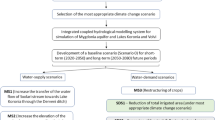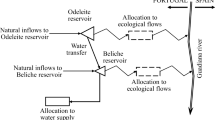Abstract
Water resources allocation is facing great challenge, since hydrological series have shown non-stationarity with high uncertainty due to climate change and human activities. Adaptive measures are suggested to respond to the challenge. Aiming at quantitatively assess the impact of adaptive measures on optimal water resources allocation, we proposed a framework based on reliability, resilience and vulnerability indicators. Two representative concentration pathway (RCP) scenarios (RCP2.6 and RCP4.5) of one global climate model were used to project future climate, and the variable infiltration capacity hydrological model was used to simulate streamflow. Three adaptive measures [water saving measure, water transfer project, dynamic control of flood limiting water levels (FLWLs) for reservoir operation] were combined to eight scenarios, then scenarios were applied to the allocation model to get different optimal allocation schemes which were assessed by RRV indicators. The results show that water saving measure decreases the vulnerability by 79 × 106 m3, water transfer project decreases the resilience by 17% in every scenario and dynamic control of FLWLs increases the reliability by 23.53% to the greatest scale. But the impacts of latter two adaptive measures are restricted to the areas which are geographically close to water supply projects. The uneven spatial distribution and decrease of streamflow will increase the risk of water shortage in the future. Optimal water allocation can reduce this risk and make 23 of 28 operational zones stable. Water saving measure is significantly valid in the rest 5 operational zones, but its impact is not positive to all water use sectors. Overall, our study helps understanding the interaction between adaptive measures and water resources system, and making guidelines for effective adaptation planning.







Similar content being viewed by others
References
Adger WN, Arnell NW, Tompkins EL (2005) Successful adaptation to climate change across scales. Glob Environ Change 15(2):77–86
Ajami NK, Hornberger GM, Sunding DL (2008) Sustainable water resource management under hydrological uncertainty. Water Resour Res. https://doi.org/10.1029/2007WR006736
Anvari S, Kim JH, Moghaddasi M (2019) The role of meteorological and hydrological uncertainties in the performance of optimal water allocation approaches. Irrig Drain 68:342–353
Asefa T, Clayton J, Adams A, Anderson D (2014) Performance evaluation of a water resources system under varying climatic conditions: reliability, Resilience, Vulnerability and beyond. J Hydrol 508:53–65
Borgomeo E, Hall JW, Fung F, Watts G, Colquhoun K, Lambert C (2014) Risk-based water resources planning: incorporating probabilistic nonstationary climate uncertainties. Water Resour Res 50(8):6850–6873
Bormann H, Ahlhorn F, Klenke T (2012) Adaptation of water management to regional climate change in a coastal region–hydrological change vs. community perception and strategies. J Hydrol 454:64–75
Chen H, Xiang T, Zhou X, Xu CY (2012) Impacts of climate change on the Qingjiang Watershed’s runoff change trend in China. Stoch Env Res Risk Assess 26(6):847–858
Chen J, Brissette FP, Chaumont D, Braun M (2013) Finding appropriate bias correction methods in downscaling precipitation for hydrologic impact studies over North America. Water Resour Res 49(7):4187–4205
Cherkauer KA, Bowling LC, Lettenmaier DP (2003) Variable infiltration capacity cold land process model updates. Global Planet Change 38(1–2):151–159
Cosgrove WJ, Loucks DP (2015) Water management: current and future challenges and research directions. Water Resour Res 51(6):4823–4839
CWRC (Changjiang Water Resources Commission) (2011) Report on the comprehensive management plan on water resources for Hanjiang River basin, China
Folke C (2006) Resilience: the emergence of a perspective for social-ecological systems analyses. Glob Environ Change 16(3):253–267
Fowler HJ, Kilsby CG, O’Connell PE (2003) Modeling the impacts of climatic change and variability on the reliability, resilience, and vulnerability of a water resource system. Water Resour Res. https://doi.org/10.1029/2002WR001778
Goharian E, Burian SJ, Bardsley T, Strong C (2015) Incorporating potential severity into vulnerability assessment of water supply systems under climate change conditions. J Water Resour Plan Manag 142(2):04015051
Guo S, Guo J, Zhang J, Chen H (2009) VIC distributed hydrological model to predict climate change impact in the Hanjiang basin. Sci China Ser E: Technol Sci 52(11):3234
Hallegatte S (2009) Strategies to adapt to an uncertain climate change. Glob Environ Change 19(2):240–247
Hashimoto T, Stedinger JR, Loucks DP (1982) Reliability, resiliency, and vulnerability criteria for water resource system performance evaluation. Water Resour Res 18(1):14–20
Hernández-Bedolla J, Solera A, Paredes-Arquiola J, Pedro-Monzonís M, Andreu J, Sánchez-Quispe S (2017) The assessment of sustainability indexes and climate change impacts on integrated water resource management. Water 9(3):213
Holland JH (1992) Adaptation in natural and artificial systems: an introductory analysis with applications to biology, control, and artificial intelligence. MIT Press, Cambridge
Holling CS (1973) Resilience and stability of ecological systems. Annu Rev Ecol Syst 4(1):1–23
Jahandideh-Tehrani M, Bozorg-Haddad O, Loáiciga HA (2019) Application of non-animal–inspired evolutionary algorithms to reservoir operation: an overview. Environ Monit Assess 191(7):439
Ji L, Huang G, Ma Q (2018) Total consumption controlled water allocation management for multiple sources and users with inexact fuzzy chance-constrained programming: a case study of Tianjin, China. Stoch Env Res Risk Assess 32(12):3299–3315
Jothiprakash V, Arunkumar R (2013) Optimization of hydropower reservoir using evolutionary algorithms coupled with chaos. Water Resour Manage 27(7):1963–1979
Kendall M (1975) Rank correlation methods. Charles Griffin, London
Kim S, Kim BS, Jun H, Kim HS (2014) Assessment of future water resources and water scarcity considering the factors of climate change and social–environmental change in Han River basin, Korea. Stoch Env Res Risk Assess 28(8):1999–2014
Konak A, Coit DW, Smith AE (2006) Multi-objective optimization using genetic algorithms: a tutorial. Reliab Eng Syst Saf 91(9):992–1007
Li Y, Lence BJ (2007) Estimating resilience for water resources systems. Water Resour Res. https://doi.org/10.1029/2006WR005636
Li X, Guo S, Liu P, Chen G (2010) Dynamic control of flood limited water level for reservoir operation by considering inflow uncertainty. J Hydrol 391(1–2):124–132
Liang X, Lettenmaier DP, Wood EF, Burges SJ (1994) A simple hydrologically based model of land surface water and energy fluxes for general circulation models. J Geophys Res Atmos 99(D7):14415–14428
Liu D (2019) Evaluating the dynamic resilience process of a regional water resource system through the nexus approach and resilience routing analysis. J Hydrol 578:124028
Liu D, Chen X, Nakato T (2012a) Resilience assessment of water resources system. Water Resour Manage 26(13):3743–3755
Liu D, Guo S, Chen X, Shao Q, Ran Q, Song X, Wang Z (2012b) A macro-evolutionary multi-objective immune algorithm with application to optimal allocation of water resources in Dongjiang River basins, South China. Stoch Env Res Risk Assess 26(4):491–507
Liu D, Guo S, Shao Q, Jiang Y, Chen X (2014) Optimal allocation of water quantity and waste load in the Northwest Pearl River Delta, China. Stoch Env Res Risk Assess 28(6):1525–1542
Liu XM, Huang GH, Wang S, Fan YR (2016) Water resources management under uncertainty: factorial multi-stage stochastic program with chance constraints. Stoch Env Res Risk Assess 30(3):945–957
Liu D, Guo S, Shao Q, Liu P, Xiong L, Wang L, Wang Z (2018) Assessing the effects of adaptation measures on optimal water resources allocation under varied water availability conditions. J Hydrol 556:759–774
Lopez A, Fung F, New M, Watts G, Weston A, Wilby RL (2009) From climate model ensembles to climate change impacts and adaptation: a case study of water resource management in the southwest of England. Water Resour Res. https://doi.org/10.1029/2008WR007499
Loucks DP (1997) Quantifying trends in system sustainability. Hydrol Sci J 42(4):513–530
Mann H (1945) Non-parametric tests against trend. Econometrica 13:245–259
Mateus C, Tullos D (2017) Reliability, sensitivity, and uncertainty of reservoir performance under climate variability in basins with different hydrogeologic settings in Northwestern United States. Int J River Basin Manag 15(1):21–37
McMahon TA, Adeloye AJ, Zhou SL (2006) Understanding performance measures of reservoirs. J Hydrol 324(1–4):359–382
Meenu R, Rehana S, Mujumdar PP (2013) Assessment of hydrologic impacts of climate change in Tunga-Bhadra river basin, India with HEC-HMS and SDSM. Hydrol Process 27(11):1572–1589
Mendoza VM, Villanueva EE, Adem J (1997) Vulnerability of basins and watersheds in Mexico to global climate change. Climate Res 9(1–2):139–145
Milly PCD, Betancourt J, Falkenmark M, Hirsch RM, Kundzewicz ZW, Lettenmaier DP, Stouffer RJ (2008) Stationarity is dead: Whither water management? Science 319(5863):573–574
Salerno F (2017) Adaptation strategies for water resources: criteria for research. Water. https://doi.org/10.3390/w9100805
Sharma D, Gupta AD, Babel MS (2007) Spatial disaggregation of bias-corrected GCM precipitation for improved hydrologic simulation: ping River Basin, Thailand. Hydrol Earth Syst Sci Dis 11(4):1373–1390
Shen M, Chen J, Zhuan M, Chen H, Xu CY, Xiong L (2018) Estimating uncertainty and its temporal variation related to global climate models in quantifying climate change impacts on hydrology. J Hydrol 556:10–24
Sun S, Wang Y, Wang F, Liu J, Luan X, Li X, Zhou T, Wu P (2015) Alleviating Pressure on Water Resources: a new approach could be attempted. Sci Rep 5:14006
Tabari MMR, Soltani J (2013) Multi-objective optimal model for conjunctive use management using SGAs and NSGA-II models. Water Resour Manage 27(1):37–53
The Standing Committee of the Eighth National People’s Congress of the People’s Republic of China (1997) Flood control law of the People’s Republic of China. http://www.gov.cn/ztzl/2006-07/27/content_347485.htm (in Chinese)
Vieira EDO, Sandoval-Solis S (2018) Water resources sustainability index for a water-stressed basin in Brazil. J Hydrol Reg Stud 19:97–109
Vörösmarty CJ, Green P, Salisbury J, Lammers RB (2000) Global water resources: vulnerability from climate change and population growth. Science 289(5477):284–288
Wang L, Guo S, Hong X, Liu D, Xiong L (2017) Projected hydrologic regime changes in the Poyang Lake Basin due to climate change. Front Earth Sci 11(1):95–113
Wang HM, Chen J, Cannon AJ, Xu CY, Chen H (2018) Transferability of climate simulation uncertainty to hydrological impacts. Hydrol Earth Syst Sci 22(7):3739–3759
Wijngaard RR, Biemans H, Lutz AF, Shrestha AB, Wester P, Immerzeel WW (2018) Climate change vs. socio-economic development: understanding the future South Asian water gap. Hydrol Earth Syst Sci 22(12):6297–6321
Wilby RL (1998) Statistical downscaling of daily precipitation using daily airflow and seasonal teleconnection indices. Climate Res 10(3):163–178
Wilby RL, Harris I (2006) A framework for assessing uncertainties in climate change impacts: Low-flow scenarios for the River Thames. Water Resour Res, UK. https://doi.org/10.1029/2005WR004065
Xin X, Wu T, Li J, Wang Z, Li W, Wu F (2013) How well does BCC_CSM1.1 reproduce the 20th century climate change over China. Atmos Ocean Sci Lett 6(1):21–26
Zhuan MJ, Chen J, Shen MX, Xu CY, Chen H, Xiong LH (2018) Timing of human-induced climate change emergence from internal climate variability for hydrological impact studies. Hydrol Res 49(2):421–437
Zhuang XW, Li YP, Huang GH, Zeng XT (2015) An inexact joint-probabilistic programming method for risk assessment in water resources allocation. Stoch Env Res Risk Assess 29(5):1287–1301
Acknowledgements
The authors gratefully acknowledge the financial support from the National Natural Science Foundation of China (Nos. 51879194, 91647106, 51579183).
Author information
Authors and Affiliations
Corresponding author
Additional information
Publisher's Note
Springer Nature remains neutral with regard to jurisdictional claims in published maps and institutional affiliations.
Rights and permissions
About this article
Cite this article
Zou, H., Liu, D., Guo, S. et al. Quantitative assessment of adaptive measures on optimal water resources allocation by using reliability, resilience, vulnerability indicators. Stoch Environ Res Risk Assess 34, 103–119 (2020). https://doi.org/10.1007/s00477-019-01753-4
Published:
Issue Date:
DOI: https://doi.org/10.1007/s00477-019-01753-4




